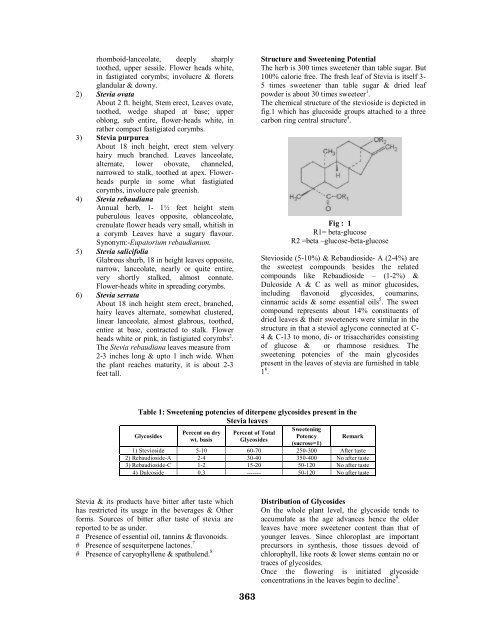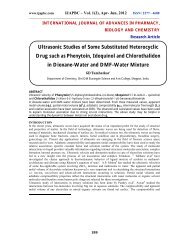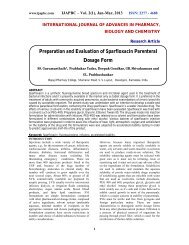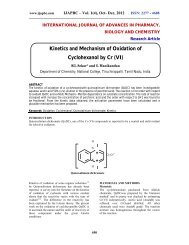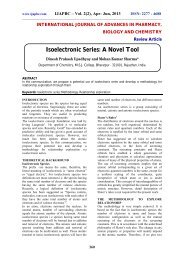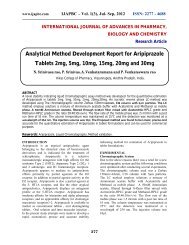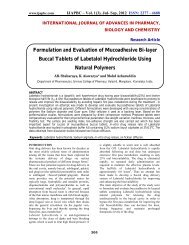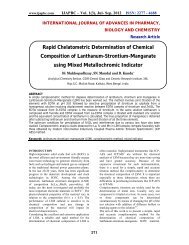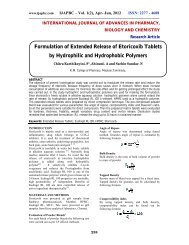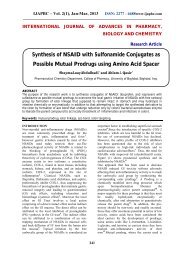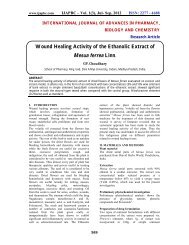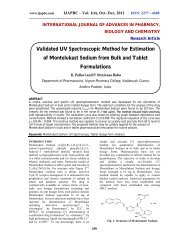An Overview on Stevia: A Natural Calorie Free Sweetener - ijapbc
An Overview on Stevia: A Natural Calorie Free Sweetener - ijapbc
An Overview on Stevia: A Natural Calorie Free Sweetener - ijapbc
You also want an ePaper? Increase the reach of your titles
YUMPU automatically turns print PDFs into web optimized ePapers that Google loves.
homboid-lanceolate, deeply sharply<br />
toothed, upper sessile. Flower heads white,<br />
in fastigiated corymbs; involucre & florets<br />
glandular & downy.<br />
2) <strong>Stevia</strong> ovata<br />
About 2 ft. height, Stem erect, Leaves ovate,<br />
toothed, wedge shaped at base; upper<br />
obl<strong>on</strong>g, sub entire, flower-heads white, in<br />
rather compact fastigiated corymbs.<br />
3) <strong>Stevia</strong> purpurea<br />
About 18 inch height, erect stem velvery<br />
hairy much branched. Leaves lanceolate,<br />
alternate, lower obovate, channeled,<br />
narrowed to stalk, toothed at apex. Flowerheads<br />
purple in some what fastigiated<br />
corymbs, involucre pale greenish.<br />
4) <strong>Stevia</strong> rebaudiana<br />
<str<strong>on</strong>g>An</str<strong>on</strong>g>nual herb, 1- 1½ feet height stem<br />
puberulous leaves opposite, oblanceolate,<br />
crenulate flower heads very small, whitish in<br />
a corymb Leaves have a sugary flavour.<br />
Syn<strong>on</strong>ym:-Eupatorium rebaudianum.<br />
5) <strong>Stevia</strong> salicifolia<br />
Glabrous shurb, 18 in height leaves opposite,<br />
narrow, lanceolate, nearly or quite entire,<br />
very shortly stalked, almost c<strong>on</strong>nate.<br />
Flower-heads white in spreading corymbs.<br />
6) <strong>Stevia</strong> serrata<br />
About 18 inch height stem erect, branched,<br />
hairy leaves alternate, somewhat clustered,<br />
linear lanceolate, almost glabrous, toothed,<br />
entire at base, c<strong>on</strong>tracted to stalk. Flower<br />
heads white or pink, in fastigiated corymbs 2 .<br />
The <strong>Stevia</strong> rebaudiana leaves measure from<br />
2-3 inches l<strong>on</strong>g & upto 1 inch wide. When<br />
the plant reaches maturity, it is about 2-3<br />
feet tall.<br />
Structure and Sweetening Potential<br />
The herb is 300 times sweetener than table sugar. But<br />
100% calorie free. The fresh leaf of <strong>Stevia</strong> is itself 3-<br />
5 times sweetener than table sugar & dried leaf<br />
powder is about 30 times sweeteer 1 .<br />
The chemical structure of the stevioside is depicted in<br />
fig.1 which has glucoside groups attached to a three<br />
carb<strong>on</strong> ring central structure 4 .<br />
Fig : 1<br />
R1= beta-glucose<br />
R2 =beta –glucose-beta-glucose<br />
Stevioside (5-10%) & Rebaudioside- A (2-4%) are<br />
the sweetest compounds besides the related<br />
compounds like Rebaudioside – (1-2%) &<br />
Dulcoside A & C as well as minor glucosides,<br />
including flav<strong>on</strong>oid glycosides, coumarins,<br />
cinnamic acids & some essential oils 5 . The sweet<br />
compound represents about 14% c<strong>on</strong>stituents of<br />
dried leaves & their sweeteners were similar in the<br />
structure in that a steviol aglyc<strong>on</strong>e c<strong>on</strong>nected at C-<br />
4 & C-13 to m<strong>on</strong>o, di- or trisaccharides c<strong>on</strong>sisting<br />
of glucose & or rhamnose residues. The<br />
sweetening potencies of the main glycosides<br />
present in the leaves of stevia are furnished in table<br />
1 6 .<br />
Table 1: Sweetening potencies of diterpene glycosides present in the<br />
<strong>Stevia</strong> leaves<br />
Glycosides<br />
Percent <strong>on</strong> dry<br />
wt. basis<br />
Percent of Total<br />
Glycosides<br />
Sweetening<br />
Potency<br />
(sucrose=1)<br />
Remark<br />
1) Stevioside 5-10 60-70 250-300 After taste<br />
2) Rebaudioside-A 2-4 30-40 350-400 No after taste<br />
3) Rebaudioside-C 1-2 15-20 50-120 No after taste<br />
4) Dulcoside 0.3 ------- 50-120 No after taste<br />
<strong>Stevia</strong> & its products have bitter after taste which Distributi<strong>on</strong> of Glycosides<br />
has restricted its usage in the beverages & Other<br />
forms. Sources of bitter after taste of stevia are<br />
reported to be as under.<br />
# Presence of essential oil, tannins & flav<strong>on</strong>oids.<br />
# Presence of sesquiterpene lact<strong>on</strong>es. 7<br />
# Presence of caryophyllene & spathulend. 8<br />
363<br />
On the whole plant level, the glycoside tends to<br />
accumulate as the age advances hence the older<br />
leaves have more sweetener c<strong>on</strong>tent than that of<br />
younger leaves. Since chloroplast are important<br />
precursors in synthesis, those tissues devoid of<br />
chlorophyll, like roots & lower stems c<strong>on</strong>tain no or<br />
traces of glycosides.<br />
Once the flowering is initiated glycoside<br />
c<strong>on</strong>centrati<strong>on</strong>s in the leaves begin to decline 9 .


